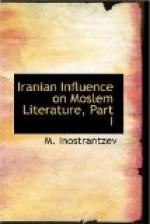[Footnote 1: For a general conspectus of the history of the provinces with regard to their independence during the Sasanian and Arab domination, see, e.g. F. Justi, G.I. Ph., II, pp. 547-49—“History of Iran from the earliest to the end of the Sasanides” in German—Appendix I.]
KHORASAN.
It was otherwise with the Eastern provinces of Khorasan, too far distant from the territary occupied by the Arab settlers, and too densely inhabited by Iranians to rapidly lose its previous characteristics. On the contrary, we know from the historians that in this province Iranian elements remained steadfast throughout the Umayyad dynasty and it was exclusively due to the support given by Khorasanians to the Abbasides that the latter succeeded in overthrowing the previous dynasty and commenced the era of powerful Iranian influences in the history of the Musalman Orient.[1] Khorasan played a vital part in the development of the modern Persian literature and especially its chief department, poetry. The entire early period of the history of modern Persian poetry, from Abbas welcoming with an ode Khalif Mamun into Merv down to Firdausi, may be labelled Khorasanian. There flourished the activity of Rudaki, Kisai, Dakiki, and other less notable representatives of the early period of modern Persian bards.[2] The culture of poetry was favoured not only by the geographical position of the province of Khorasan but by its political conditions. Already in the beginning of the ninth century in Khorasan there had arisen national Persian dynasties and under their patronage began the renascence of the Persian nation (Taherides, Saffarides, Samanides).
[Footnote 1: On the history of Khorasan in the Umayyad period see J. Wellhausen Das Arabische Reich und Sein Sturz, p, 247 f. and p. 306 f.]
[Footnote 2: See the general survey of this period in J, Darmesteter, “The Origins of the Persian Poesy”, in French and E.G. Browne “Literary History of Persia”, I, p, 350 ff.]




